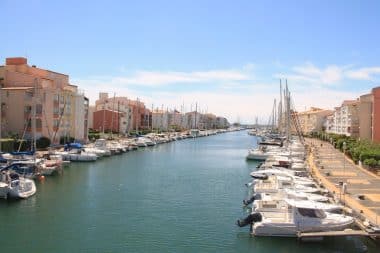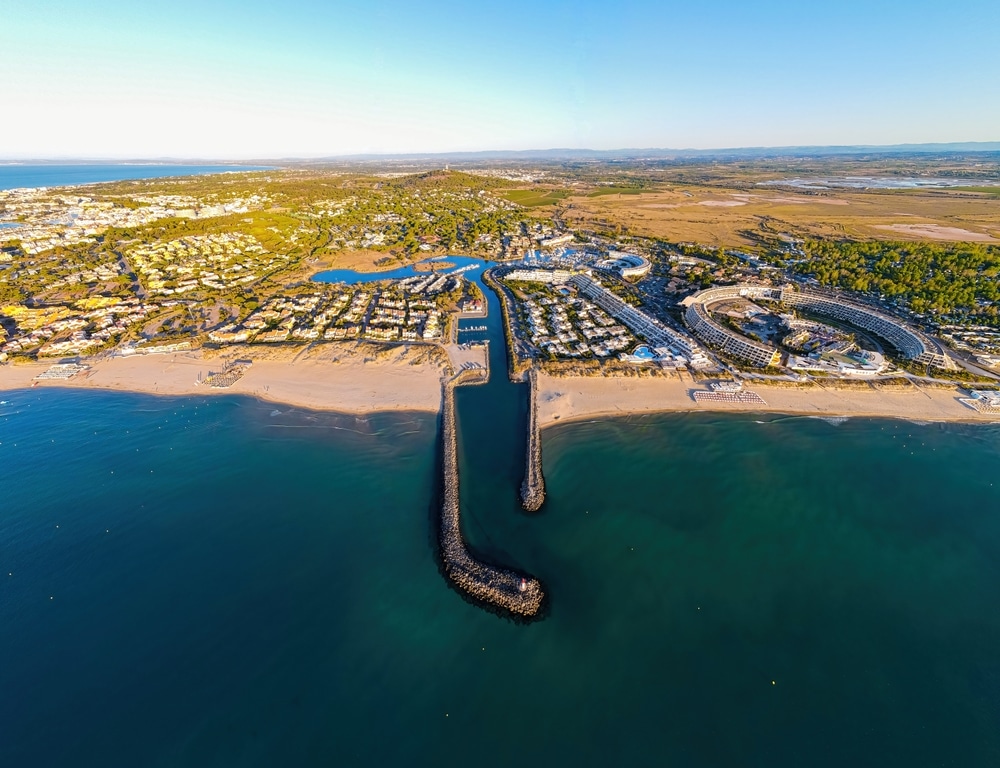Cap d’Agde, a picturesque spot on France’s Mediterranean coast, is a true gem for travelers looking for something special. Known for its diverse beaches, pleasant climate and vibrant culture, this place offers something for every holidaymaker. In this comprehensive guide, you’ll discover everything Cap d’Agde has to offer, from the best times to visit to the most beautiful beaches and cultural highlights.
Climate in Cap d’Agde
The climate in Cap d’Agde is typically Mediterranean, with hot summers and mild winters. The best time to visit is between June and September, when the weather is ideal for beach visits and outdoor activities. The average temperatures in the summer months are between 23°C and 28°C, while the water temperatures reach a pleasant 22°C to 25°C. In winter, the average temperatures are between 10°C and 15°C, which makes for mild and pleasant weather, ideal for sightseeing and leisurely walks along the coast.
Climate table
- Spring (March – May): Average temperature 13°C – 20°C
- Summer (June – August): Average temperature 23°C – 28°C
- Autumn (September – November): Average temperature 18°C – 25°C
- Winter (December – February): Average temperature 10°C – 15°C
Beaches of Cap d’Agde
Cap d’Agde is known for its variety of beaches, ranging from family-friendly sandy beaches to quiet coves. The most famous beach is the Plage Richelieu, a vast sandy beach perfect for sunbathing and water sports. Plage Rochelongue is ideal for families, as it slopes gently and is therefore safe for children. Nature lovers will appreciate the Plage de la Grande Conque, an impressive bay surrounded by cliffs and crystal clear waters.
On the coast of Agde, there are eleven supervised beaches between Cap d’Agde and La Tamarissière. The beaches of La Tamarissière, Le Grau d’Agde, Saint-Vincent, Baie de l’Amitié, Rochelongue, Richelieu, La Plagette, La Grande Conque, Le Môle, La Roquille and the nudist beach are all located in a tourist area of 14 kilometres that offers something for all tastes.
Nature and outdoor activities

In addition to the beaches, Cap d’Agde offers a breathtaking natural setting that invites you to explore. The Parc Naturel Régional du Haut-Languedoc is a must-see for hikers and nature lovers. Here you will find scenic hiking trails that lead through unspoiled landscapes and charming villages. Water sports enthusiasts will also get their money’s worth: sailing, windsurfing and diving are popular activities in the waters around Cap d’Agde.
Cultural highlights and sights
Cap d’Agde is not only a beach paradise, but also rich in culture and history. A visit to the historic old town of Agde, which is only a few kilometres away, is an absolute must. Admire the medieval architecture and visit the impressive Saint-Étienne d’Agde Cathedral. For art lovers, the Musée Agathois is a fantastic place to learn more about local history and culture.
Destinations
- With its 3100 berths, the Cap d’Agde marina with its 3100 berths not only attracts seafarers, but is the ideal place to browse the numerous boutiques in a water-sports environment and later relax in the bars and restaurants with a drink or ice cream.
- The volcanic cliffs are a popular destination all year round. They were created by volcanic eruptions and from the top of the cliffs there is a fantastic view of Cap d’Agde, the coast and the sea.
- A city of art and history, Pézenas has an exceptional heritage. The city exudes the typical Mediterranean charm through its historic buildings and was the long-time residence of the famous French artist Molière. The city celebrates the memory of Molière’s legacy throughout the year with theatre performances and symposia.
- The Canal du Midi is a waterway that connects the city of Toulouse to the Mediterranean Sea and is a UNESCO World Heritage Site. The construction period was 14 years. With its many aqueducts, dams, locks and bridges, the canal is a masterpiece of architecture and can be explored on a tour, a bike ride or a walk.
- A visit to the nature reserves of Le Bagnas and Grande Maïre gives nature lovers the opportunity to learn more about the flora and fauna of the region and to take part in organised nature observations and excursions.
- An architectural highlight from the Middle Ages are the towns of Caux, Saint-Pons de Mauchiens and Nézignan l’Evêque, which were built as a round village. In this construction method, the buildings were built in a circle around a protective structure, usually a castle. Such a bulwark served the purpose of stopping the approaching enemy.
- The region around Cap d’Agde has another attraction in store with the Saint-Etienne Cathedral. It was originally built in 872 as a Carolingian church and expanded in 1173 with embrasures and a battlement, among other things. The cathedral has a 35-metre-high tower, is made of basalt stone and contains some valuable pieces inside. Examples include the former sacristy of the canons, the baroque organs made of polychrome wood and the painting portraying the stoning of St. Stephen.
- Along the region’s wine route are the wineries of numerous winegrowers, who make the tradition of wines come alive. A hike through the vineyards offers the opportunity to learn more about the craft of winemaking, visit a wine cellar and attend a wine tasting or two. Wine lovers will get their money’s worth here.
Gastronomy in Cap d’Agde
The gastronomy in Cap d’Agde is characterized by fresh seafood and regional specialties. Enjoy dinner at one of the many beachfront restaurants, where you can enjoy fresh fish and seafood right by the sea. You can also taste the local wines grown in the surrounding Languedoc vineyards.
Accommodation and transport connections
In Cap d’Agde there is a wide variety of accommodation, from luxury hotels to cozy apartments. The place is easily accessible by car and is close to larger cities such as Montpellier and Béziers. The local Béziers Cap d’Agde airport also offers good connections for international travellers.
Arrival from Germany
From Germany, you can fly from Frankfurt, Dusseldorf or Stuttgart to Montpellier or Béziers in France and from there take a taxi or rental car to Cap d’Agde. From Montpellier, the journey time is one hour, from Béziers only 25 minutes.
Cap d’Agde can be reached by train from Germany. Since March 2012, a railway line has been in operation in France, which ensures shorter travel times. Numerous trains are used to travel from Frankfurt via Mannheim and Karlsruhe to Marseille . Three trains will be used between Marseille and Montpellier. From Frankfurt
to Marseille the required travel time is about eight hours and from there the train station of Cap d’Agde can be reached quickly.
If you are travelling by car, it should be noted in advance that France introduced an environmental badge for various regions and cities of the country a few years ago. This should be ordered directly from the French authorities before the start of the trip. It costs about four euros and will be sent by post. A possible route for arriving by car is the A35 at Lauterbourgh to Mulhouse, then take the A36 to Beaune and later change to the A6 to Lyon and the A7 to Orange. At orange, turn onto the A9 towards Spain and exit the motorway at Bessan to get to Cap d’Agde. France charges tolls for the use of motorways.
Result:
Cap d’Agde is a versatile destination that combines culture, nature and relaxation in a unique way. Whether you’re looking for a beach holiday, cultural discoveries or culinary experiences, Cap d’Agde has something for everyone. Plan your next holiday in this charming town on the French Mediterranean coast and experience unforgettable moments


